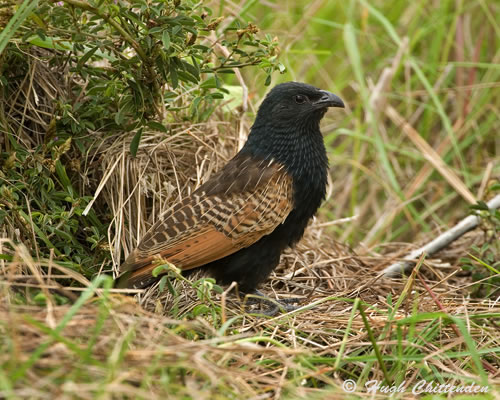THE CROW PHEASANT!Though we prefer to call it the Greater Coucal, if only to protest against the simply unacceptable combination of the names of two other animals to name this one-of-a-kind bird.
 |
| Greater Coucal, possibly with its own nest (Centropus sinensis) |
This relatively large bird which is about 48-52cm, is a common resident throught Southeast Asia, except in Singapore(what a shocker...*rolling our collective eyes at this point*). Interestingly, although the Greater Coucal is part of the cuckoo order of birds, which are known to be parasitic*, this bird does not try to pawn off its parental duties on some poor unsuspecting bird.
Bet you didn't know(because neither did we): Surprisingly, there is a reversal of gender roles amongst these birds (but then again...maybe we're the one's who've got it on the wrong way around). The papa Coucal does more parenting than the mama Coucal! He's got the heavy responsibility of building the nest, warming his little babies by sitting on them(well...not them them- rather, the eggs they're in). And after all that's done, he even does the baby bird feeding. The females do help... but they prefer sitting around looking pretty, advertising their... goods.
Greater coucals are known to be monogamous birds(You jump, I jump). Whether, or how frequently they cheat on their other halves, we're not quite sure of, unfortunately. BUT, amongst a close relative of the Greater coucal, the Black coucal(Centropus grillii) (Below), females commonly have more than one partner! So while the male is left busy attending to their offspring.. she's off making more babies with some other sexy, dashing, Romeo...
Greater coucals are known to be monogamous birds(You jump, I jump). Whether, or how frequently they cheat on their other halves, we're not quite sure of, unfortunately. BUT, amongst a close relative of the Greater coucal, the Black coucal(Centropus grillii) (Below), females commonly have more than one partner! So while the male is left busy attending to their offspring.. she's off making more babies with some other sexy, dashing, Romeo...
 |
| Black Coucal (Centropus grillii) [Image adapted from this website on 5th May 2010] |
The result of this reversal of sex roles, is that the females are the macho ones in the relationship, i.e. they're bigger and heavier (& meaner?) Who said females were the weaker sex eh? :)
Zebutionary
Parasitic* : No, "parasitic" here does not mean that they burrow into the skin of other animals and proliferate and possibly even kill their host. With regards to birds, this usually means that they lay their eggs in other birds' nests, leaving others to raise their babies, which may or may not be baby killers. In the extreme case of the European cuckoo, when hatched, the young will clear the nest of its other unrelated occupants- by shoving them out of their nest, to their DOOM! Clearly, babies are not as sweet and innocent as we think they are.
References
Andersson, M. (1995). Evolution of reversed sex roles, sexual size dimorphism, and mating system in coucals (Centropodidae, Aves). Biological Journal of the Linnean Society , 193-200.
Robson, C. (2005). Birds of Southeast Asia. United States and Canada: Princeton University Press.
Stanford University. (1999, December 30). Brood Parasitism. Retrieved May 5, 2010, from Stanford University: http://www.stanford.edu/group/stanfordbirds/text/essays/Brood_Parasitism.html


No comments:
Post a Comment